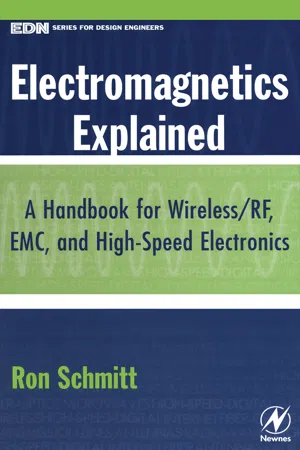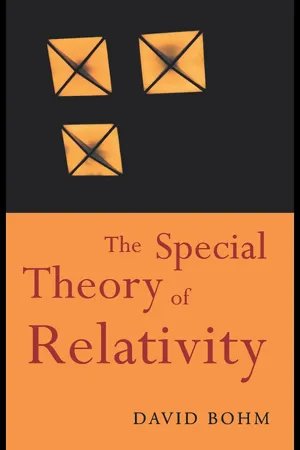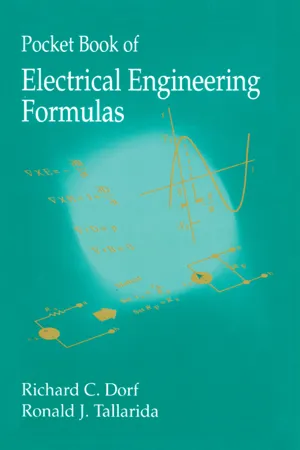Electric Fields
Electric fields are regions of space around electrically charged particles where other charged particles experience a force. They are represented by vectors that indicate the direction and strength of the force experienced by a positive test charge placed in the field. The strength of an electric field is determined by the magnitude of the source charge and the distance from it.
7 Key excerpts on "Electric Fields"
- eBook - ePub
Electrical Engineering
Fundamentals
- Viktor Hacker, Christof Sumereder(Authors)
- 2020(Publication Date)
- De Gruyter Oldenbourg(Publisher)
...If the electric field is created by a stationary electric charge, we talk about an electrostatic field. Each electric charge is surrounded by an electric field. Electric charges interact and affect each other: Like charges repel each other. Unlike charges attract each other. A charged particle moves along an imaginary line in the electric field. Such lines of occurring forces are called electric field lines. The following applies for electric field lines: Direction: The electric field lines start at the positive charge (source) and end at the negative charge (sink). Electric field lines always start and end on the surface of an electric charge. Electric field lines always leave the surface of the electric charge in a right angle. Field lines do not intersect. The denser the field lines, the stronger the force exerted on the charges. From a mathematical point of view, the electric field is a vector field of the electric field strength. It assigns a vector for direction and magnitude of electric field strength to each point in the space. Figure 1.14: Attracting force and Repulsive force of charges. The electric field is the cause for forces exerted on charges. According to the first of Newton’s axioms, a body accelerates as long as force is exerted on it. Moving charge carriers are called current. The sources of an electric field are positive charges, sinks and negative charges. The electric field [Vm −1 ; NC −1 ] is uniform when neither its magnitude nor its direction changes from one point to another. 1.7.1 Force on charged particle in electric field The electric field strength is the measure of the force, a charged body experiences in an electric field...
- eBook - ePub
Electromagnetics Explained
A Handbook for Wireless/ RF, EMC, and High-Speed Electronics
- Ron Schmitt(Author)
- 2002(Publication Date)
- Newnes(Publisher)
...2 FUNDAMENTALS OF Electric Fields THE ELECTRIC FORCE FIELD To understand high-frequency and RF electronics, you must first have a good grasp of the fundamentals of electromagnetic fields. This chapter discusses the electric field and is the starting place for understanding electromagnetics. Electric Fields are created by charges; that is, charges are the source of Electric Fields. Charges come in two types, positive (+) and negative (–). Like charges repel each other and opposites attract. In other words, charges produce a force that either pushes or pulls other charges away. Neutral objects are not affected. The force between two charges is proportional to the product of the two charges, and is called Coulomb’s law. Notice that the charges produce a force on each other without actually being in physical contact. It is a force that acts at a distance. To represent this “force at distance” that is created by charges, the concept of a force field is used. Figure 2.1 shows the electrical force fields that surround positive and negative charges. Figure 2.1 Field lines surrounding a negative and a positive charge. Dotted lines show lines of equal voltage. By convention, the electric field is always drawn from positive to negative. It follows that the force lines emanate from a positive charge and converge to a negative charge. Furthermore, the electric field is a normalized force, a force per charge. The normalization allows the field values to be specified independent of a second charge. In other words, the value of an electric field at any point in space specifies the force that would be felt if a unit of charge were to be placed there. (A unit charge has a value of 1 in the chosen system of units.) Electric field = Force field as “felt” by a unit charge To calculate the force felt by a charge with value, q, we just multiply the electric field by the charge, The magnitude of the electric field decreases as you move away from a charge, and increases as you get closer...
- eBook - ePub
Energy Medicine - E-Book
The Scientific Basis
- James L. Oschman(Author)
- 2015(Publication Date)
- Churchill Livingstone(Publisher)
...This electric field influences other electrically charged objects. There are two ways of describing the influences of fields and the ways they interact with each other. One perspective is that objects have properties that modify the space around them such that another object entering that space will have a force exerted upon it. A second perspective does not require the concept of force: Objects have properties that modify the space around them such that another object entering that space will experience a change in its motion. In the case of the electron, shown in Figure 2.2, the lines of force reveal the direction of motion a positive test charge would experience when brought into the space around the electron. Specifically, since opposite charges attract, the positive test charge will be drawn towards the center of charge of the electron. Figure 2.2 The electric field of a stationary electric charge. Note that the charge is imaged as a point in space. This is a simplification that has made it easier to calculate charge interactions. However, there are other valuable perspectives on the nature of the electric charge that will be discussed in this chapter. With regard to the image of the electron shown in Figure 2.2, recognize that the view of the electron as a point in space is but one of several models of the electron and other charged particles. What is an Electron? Much of the discussion that follows will concern the behaviour of electrons and other charged particles. We shall see that when a charge moves, magnetic fields are produced. And we will also see that the opposite is true: Magnetic fields alter the motions of nearby charges. These principles are profoundly important for energy medicine. Many of the techniques used in energy medicine look like New-Age hocus-pocus until they are viewed through the discerning eyes of the physicist and biophysicist...
- G. Jagadeeswar Reddy, T. Jayachandra Prasad(Authors)
- 2020(Publication Date)
- CRC Press(Publisher)
...Chapter 1 Static Electric Fields 1.1 Introduction Electrostatic in the sense static or rest or time in-varying Electric Fields. Electrostatic field can be obtained by the distribution of static charges. The two fundamental laws which describe electrostatic fields are Coulomb’s law and Gauss’s law: They are independent laws. i.e., one law does not depend on the other law. Coulomb’s law can be used to find electric field when the charge distribution is of any type, but it is easy to use Gauss’s law to find electric field when the charge distribution is symmetrical. 1.2 Coulomb’s Law This law is formulated in the year 1785 by Coulomb. It deals with the force a point charge exerts on another point charge; generally a charge can be expressed in terms of coulombs. 1 coulomb = 6 × 10 18 electrons 1 electron charge = − 1.6 × 10 − 19 Coulombs Coulomb’s law states that the force between two point charges Q 1 and Q 2 is along the line joining between them, directly proportional to the product of two point charges, and inversely proportional to the square of the distance between them ∴ F = K Q 1 Q 2 R 2 where K is proportional constant In SI, a unit for Q 1 and Q 2 is coulombs(C), for R meters(m) and for F. newtons(N). K = 1 4 π ∊ 0 where ∊ 0 = permittivity of free space (or) vacuum = 8.854 × 10 − 12 farads / meter = 10 − 9 36 π farads / m K = 36 π 4 π × 10 − 9 = 9 × 10 9 m / farads F = Q 1 Q 2 4 π ∊ 0 R 2 (1.2.1) Assume that the point charges Q 1 and Q 2 are located at (x 1, y 1,. z 1) and (x 2, y 2, z 2) with the position vectors r ¯ 1 and r ¯ 2 respectively. Let the force on Q 2 due to Q 1 be F ¯ 12 which can be written as F ¯ 12 = Q 1 Q 2 4 π ∊ 0 R 2 a ¯ R 12 (1.2.2) where a ¯ R 12 is unit vector along the vector R ¯ 12. Graphical representation of the vectors in rectangular coordinate system is shown in Fig.1.1 Fig...
- eBook - ePub
- David Bohm(Author)
- 2003(Publication Date)
- Routledge(Publisher)
...The forces between atoms, responsible for binding them into molecules, and ultimately into macroscopic solid objects were, on plausible grounds, surmised to originate in the attractive forces between electrons and the positively charged part of an atom, and the repulsive forces between electrons and electrons. Consider, for example, a crystal lattice. The places where such electrical forces come to a balance would then determine the distance D between successive atoms in the lattice, so that, in the last analysis, the size of such a crystal containing a specified number of atomic steps in any given direction is determined in this way. Lorentz assumed that the electrical forces were in essence states of stress and strain in the ether. From Maxwell’s equations (assumed to hold in the reference frame in which the ether was at rest) it was possible to calculate the electromagnetic field surrounding a charged particle. For a particle at rest in the ether, it followed that this field was derivable from a potential,, which was a spherically symmetric function of the distance R from the charge, i.e., (where q is the charge of the particle). When a similar calculation was done for a charge moving with a velocity v through the ether, it was found that the force field was no longer spherically symmetric. Rather its symmetry became that of an ellipse of revolution, having unchanged diameters in the directions perpendicular to the velocity, but shortened in the direction of motion in the ratio This shortening is evidently an effect of the movement of the electron through the ether. Because the electrical potential due to all the atoms of the crystal is just the sum of the potentials due to each particle out of which it is constituted, it follows that the whole pattern of equipotentials is contracted in the direction of motion and left unaltered in a perpendicular direction, in just the same way as happens with the field of a single electron...
- eBook - ePub
- Richard C. Dorf, Ronald J. Tallarida(Authors)
- 2018(Publication Date)
- CRC Press(Publisher)
...26 Static Electric Fields 1. Unit Vectors and Coordinate Systems The unit vectors for the Cartesian (rectangular) system shown in Figure 26.1(a) are a x, a y, a z and all three vectors are constant. The unit vectors for the cylindrical coordinate system shown in Figure 26.1(b) are a ρ, a ϕ, a z where a z is constant. The unit vectors for the spherical coordinate system shown in Figure 26.1(c) are a r, a θ, a ϕ 2. Coulomb’s Law For two-point charges Q 1 the source of the field force F, and Q we have the force. on Q as F = Q 1 Q 4 π ∈ 0 R 2 a R (N) where a R is the vector of unit length pointing from Q 1 to Q, ϵ 0 = 10 −9 (36 π), and R is the distance between the charges. FIGURE 26.1. Unit vectors for (a) Cartesian, (b) cylindrical, and (c) spherical coordinates. Electric Field Intensity The electrostatic field intensity is defined as the force on Q when Q = 1 C so E = Q 1 4 π ϵ 0 R 2 a R (V / m) and F = Q E (N) 3. Gauss’ Law Electric flux. density, D, is D = ϵ 0 E (C / m 2) Gauss’ law states that the net flux of D, or electric flux ψ passing through a surface is equal to the net positive charge enclosed within the surface and thus ψ = ∮ D s ⋅ d S = Q where D s, is the value of D at the surface and dS is the surface element. 4. Maxwell’s Equation (Electrostatics) The electric flux per unit volume leaving a vanishingly small volume unit is equal to the volume charge density there: div D = ρ where div is divergence and ρ is a volume charge density. Using div D = ∇ · D, we have ∇ ⋅ D = ρ 5. Poisson’s Equation ∇ · ∇ V = − ρ ∈ or ∇ 2 V = − ρ ε where E = − ∇ V. 6. Current Density The current density J is related to the electric field E for a metallic conductor as J = σ E where σ is the conductivity of the conductor. The current density J is a convection current J = ρ υ where υ is a velocity vector and ρ is the volume charge density....
- eBook - ePub
Fields of Force
The Development of a World View from Faraday to Einstein.
- William Berkson(Author)
- 2014(Publication Date)
- Routledge(Publisher)
...Maxwell assumed that the total displacement (D) is directly proportional to the force acting on the ball; the constant of proportionality is analogous to the dielectric constant or specific inductive capacity (ε) of the medium (D =ε E). The energy of the electrical field will be analogous to the elastic energy of the distorted particles. This energy must be equal to the work done in distorting the particles—the force exerted by the vortices multiplied by the distance the material is displaced (which is proportional to ED =ε E 2). In Maxwell’s model charge is supposed to be caused by a pressure exerted by the electrical particles upon each other. The pressure is analogous to electrical potential or tension (ψ). The difference in the pressure on two sides of an electrical partiele will give rise to the part of electromotive force caused by static electricity. A charged body is one whose electrical particles exert a net pressure upon the particles of the surrounding dielectric. The cause of this pressure, we should note, must be alien to the mechanism itself. Maxwell derived his equations in three stages. First, he used the assumption of the vortices to account for purely magnetic effects. Second, he used the assumption of the electrical balls to derive the relations between current and magnetism, including induction. Third, he used the assumption of elasticity of the electrical balls to account for the effects of static charge. Each of these stages were steps towards Maxwell’s crowning achievement: the electromagnetic theory of light. The idea of the initial stage is very ingenious; the development of the idea is relatively straightforward. As mentioned before, Maxwell took as his starting point Faraday’s suggestion that there is a tension along the lines of force and a pressure between them...






